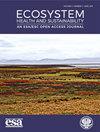一种修正的热湿指数的建立及其在城市植被斑块人体热舒适度中的应用
IF 3.4
2区 环境科学与生态学
Q1 ECOLOGY
引用次数: 3
摘要
摘要极端炎热的环境会引发严重的健康问题。为了评估小气候对热舒适性的影响,我们提出并验证了一种修正的热湿度指数(MTHI),该指数将空气温度和相对湿度与地表温度(LST)相结合。与仅包括T和RH的一般热湿度指数相比,MTHI对小气候变化更敏感,因此可以更好地指示热舒适性。在一项城市河岸缓冲区研究中,我们估计了47个植被斑块的MTHI值的时间动态和空间分布,并探讨了斑块的结构特征如何影响热舒适性。结果表明,种植能显著降低LST和MTHI。垂直结构复杂的植被斑块比结构简单的植被斑块具有更高的热舒适性。减少与河流的最近距离或增加植物数量可以减少热不适。具有MTHI 70的贴片之间的结构特征存在显著差异,这意味着贴片结构的热舒适性变化的临界阈值。考虑到人们在七月的白天总是感到不舒服,优化斑块结构对于改善城市景观的小气候调节服务至关重要。本文章由计算机程序翻译,如有差异,请以英文原文为准。
Development of a modified thermal humidity index and its application to human thermal comfort of urban vegetation patches
ABSTRACT Extremely hot environments can trigger serious health problems. To evaluate the effects of microclimate on thermal comfort, we proposed and validated a modified thermal humidity index (MTHI) that combined air temperature and relative humidity with land surface temperature (LST). MTHI was more sensitive to microclimate changes than the general thermal humidity index that includes only T and RH, and thus the thermal comfort could be better indicated. In an urban riparian buffer study, we estimated the temporal dynamics and spatial distribution of MTHI values for 47 vegetation patches and explored how structural characteristics of patches affect the thermal comfort. The results showed that planting could significantly reduce LST and MTHI. Vegetation patches with complex vertical structures had considerably higher thermal comfort than those with simple structures. Decreasing nearest distance to river or increasing plant abundance could reduce the thermal discomfort. There were significant differences in the structure characteristics between the patches with MTHI <70 and those with MTHI >70, implying the critical thresholds of variations in thermal comfort with patch structure. Given that people always feel uncomfortable during the daytime in July, optimizing the patch structure is essential to improve the microclimate regulation services of an urban landscape.
求助全文
通过发布文献求助,成功后即可免费获取论文全文。
去求助
来源期刊

Ecosystem Health and Sustainability
Environmental Science-Management, Monitoring, Policy and Law
CiteScore
7.10
自引率
2.00%
发文量
40
审稿时长
22 weeks
期刊介绍:
Ecosystem Health and Sustainability publishes articles on advances in ecology and sustainability science, how global environmental change affects ecosystem health, how changes in human activities affect ecosystem conditions, and system-based approaches for applying ecological science in decision-making to promote sustainable development. Papers focus on applying ecological theory, principles, and concepts to support sustainable development, especially in regions undergoing rapid environmental change. Papers on multi-scale, integrative, and interdisciplinary studies, and on international collaborations between scientists from industrialized and industrializing countries are especially welcome.
Suitable topics for EHS include:
• Global, regional and local studies of international significance
• Impact of global or regional environmental change on natural ecosystems
• Interdisciplinary research involving integration of natural, social, and behavioral sciences
• Science and policy that promote the use of ecological sciences in decision making
• Novel or multidisciplinary approaches for solving complex ecological problems
• Multi-scale and long-term observations of ecosystem evolution
• Development of novel systems approaches or modeling and simulation techniques
• Rapid responses to emerging ecological issues.
 求助内容:
求助内容: 应助结果提醒方式:
应助结果提醒方式:


